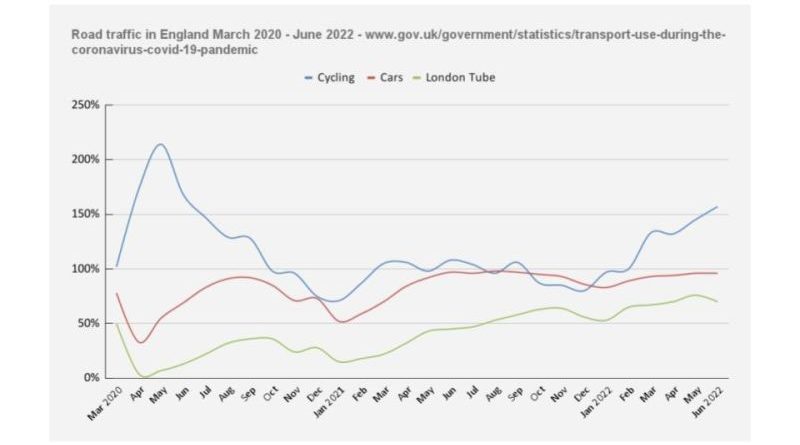Department for Transport data shows 2022 cycling rates rising sharply
Data published by the Department for Transport has shown a sharper than usual increase in cycling rates from the start of 2022 compared to prior winter to spring periods.
Though by many accounts the marketplace is slowing, aligning to a trend of dipping consumer buying power, cycling rates have flourished as other transport forms have become expensive and impractical when weighed against cost controls for families (though the data sadly does not confirm whether the cycling is leisure or transport cycling).
Put into the graph at the head of this article by bike business development specialist Mark Brown, English cycling rates got out of the blocks early this year and continued a steep trend into early summer; now shown to be north of 150% up against the first weeks pre lockdown in 2020.
The findings have been reaffirmed by Cycling UK today, who have trends against last year (not pre-pandemic) as 47% ahead on weekdays and 27% on weekends in the five months to the end of July. This arguably suggests greater commuter cycling increases, which would align to petrol price increases and rail disruption – from January to June the cost per litre on petrol has jumped by around 30%.
Cycling UK wrote on the subject today as fuel prices reached record highs in July, cycling levels were even higher than those seen at the same period in 2020, when quieter roads during the pandemic encouraged many more people out on their bikes.
Duncan Dollimore, head of campaigns at Cycling UK, said: “Rising fuel prices have triggered some people to think about their transport choices, switching some of their car journeys to cycling. But too many people don’t feel like they have that option because they don’t think our roads are safe enough to cycle on.
“The answer to that is more and better infrastructure for cycling and walking, giving more people the opportunity to do so safely rather than default to driving a short trip to work or the shops.
“With 71% of all journeys made in the UK under five miles, switching some of those to cycling is a simple way to help people make ends meet during the cost-of-living crisis, with additional health, wellbeing and environmental benefits. But to give people that choice we need local authorities to act now to make active travel a realistic option and help people keep moving.”
London cycling rates, including hiring
In London the trend has been reported to be up 24% on pre-Covid cycling rates, according to Transport for London’s own tracking from March through to June.
Giving some clues as to the transport versus leisure usage in the data, it is weekends that have led the greatest surge in usage, said to be up 82% versus 2019 rates. Meanwhile, weekday rates are likewise up, but by a shallower degree at 14%.
Analysis of London’s official bike hire data show that January, February and March were markedly ahead of the year prior at 82.6%, 46.7% and 41% up, respectively. The trend continued into spring with May up 30.3% and June up 8.6%. Hires lasted longer in the spring months for obvious reasons, though were only marginally different to the tune of two to three minutes, on average.
Cycling UK is encouraging people who have opted to cycle more due to fuel price rises to share their experiences on social media using the hashtag #DriveLessCycleMore.



